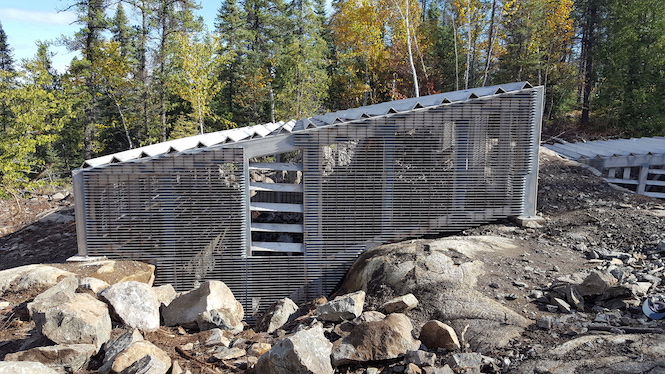
Bat Friendly Progressive Mine Rehabilitation
December 20, 2018
By Paul Palmer, P.Eng. and Josip Balaban, P.Eng.
The Edison Mine in northeastern Ontario required an innovative rehabilitation approach to protect a species at risk.
(This article first appeared in the December 2018 edition of Canadian Consulting Engineer magazine)

Completed Edison open cut cupola with bat-friendly 146-mm spacing between all steel members.
The historic Edison Mine property is a century-old silver mine located in a remote area of Coleman Township, 8 km outside of Latchford, Ont., about five hours straight north of Toronto in northeastern Ontario. Mining occurred here for only a few years before stopping in 1907 leaving unprotected physical mine hazards on site. To eliminate any liabilities associated with the historic mine, the Eaton Corporation retained Golder to complete a progressive rehabilitation of the property.
The progressive rehabilitation of physical mine hazards is governed by the Ontario Mining Act (O. Reg. 240/00) and Ministry of Energy, Northern Development and Mines (MENDM). Acceptable rehabilitation options include the following:
- Permanent Fencing—requires monitoring in perpetuity;
- Engineered Fill—crequires a clear understanding of mine workings;
- Engineered Caps—a costly, permanent solution.
Also, there are currently four species of bats in Ontario identified as species at risk, and during the winter months they hibernate in abandoned underground mine workings in northern Ontario. The bats are threatened by a disease known as white nose syndrome and it disrupts their hibernation cycle causing them to burn through their body fat supplies before they can be replenished. This disruption in their hibernation cycle has decimated the bat population in Ontario.
The Ministry of Natural Resources and Forestry (MNRF) identified the underground mine workings as a potential location for bat hibernacula and therefore designated the mine workings as protected habitat for species at risk.
Due to this classification, the three physical mine hazards (adit, shaft, open cut) connected to the underground workings were to be preserved and left open, which meant existing rehabilitation practices (i.e. capping, backfilling) could not be implemented.
The remote location of the mine made fencing the most viable solution but would not satisfy Eaton’s requirements of a solution that did not require monitoring in perpetuity (i.e. no fencing).
Given that the conventional rehabilitation measures listed above would either inhibit access to the underground workings by bats, or were not a permanent solution, a unique engineered rehabilitation solution for these three surface openings was required.
Through a 16-month design and consultation process involving Golder, Eaton, the MENDM and the MNRF, it was determined that the three open physical mine hazards be rehabilitated with permanent engineered stainless steel bat cupolas and bat gate.
Bat cupolas and bat gates are designed to preserve protected bat habitat while preventing inadvertent access to the mine workings.
The Ontario Mining Act does not provide specific applicable design requirements for the construction and installation of bat-friendly structures. Golder was required to create a site-specific cupola and bat gate design that would satisfy the MENDM and MNRF. The final design had to meet the following criteria:
- constructed of stainless steel;
- adequately anchored to bedrock;
- design load that accounts for dead weight of structure, snow loading, tree impacts and vehicle (ATV/snowmobile) traffic;
- prevent inadvertent access to mine;
- steel spacing of 146 mm to not impede the flight path of bats.
The remoteness of the site and undulating topography made data collection and design work difficult. To aid in the design, Golder completed LiDAR scans and generated a detailed 3D model of the mine openings.
The mine site is located in a remote forested area of northern Ontario only accessible by boat followed by a 5 km hike along a historic mining trail cut through the rough terrain of northern Ontario. Given logistical challenges of the remote location, cost-effective and efficient solutions needed to be implemented to safely transport all personnel, materials and equipment to site.
A barge was used to transport larger equipment (excavator, ATV’s/UTVs) 12 km up the Montreal River. Once all equipment was unloaded along the shore of the river, it was driven across the rough 5 km trail to site.
A helicopter was used to complete 45 lifts and transport 25,000-lbs of material and equipment required for the fabrication and installation of the two bat cupolas and bat gate. A lifting sequence had to be generated to ensure helicopter capacities were met while optimizing the delivery of all material and equipment.
The installation of three bat-friendly structures occurred over a short construction schedule (June-August) due to the migration pattern of bats.
Through collaboration with several disciplines and ministries over a two and a half year project schedule, Golder safely and under budget rehabilitated the mining property to meet the requirements of the MENDM, MNRF and Eaton. The fabrication and installation of the two cupolas and bat gate were one of the first bat-friendly structures to be constructed by a private enterprise in Ontario. The project successfully protected bat habitat for species at risk and prevented inadvertent access into the underground mine workings protecting the public’s safety.
Paul Palmer, P.Eng., Mine Engineering & Stability Division Leader, Paul_Palmer@golder.com; Josip Balaban, P.Eng., Mine Remediation Specialist, Josip_Balaban@golder.com